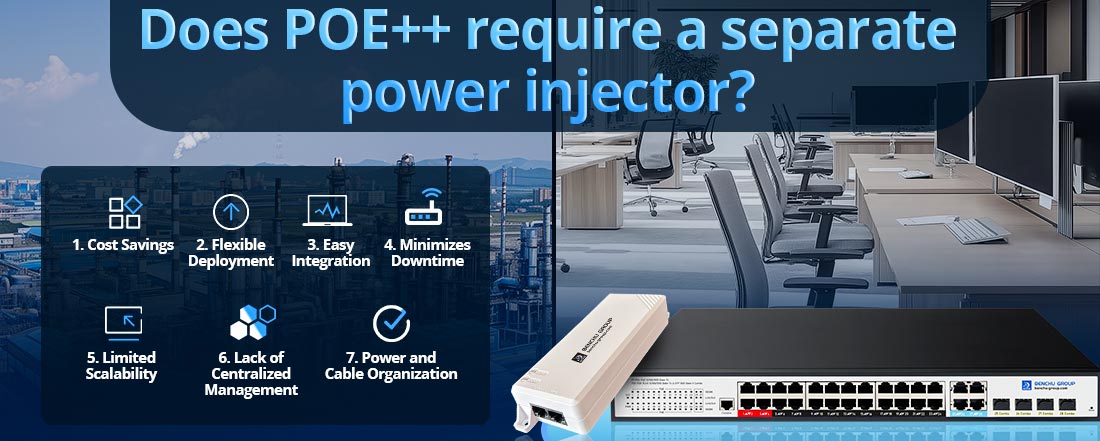
لا يتطلب PoE++ بطبيعته حاقن طاقة منفصلاً لأن محولات الشبكة التي تدعم PoE++ يمكنها توفير الطاقة مباشرة للأجهزة المتصلة من خلال كابل Ethernet. ومع ذلك، في ظروف معينة، يمكن استخدام حاقن طاقة PoE++ منفصل لتوصيل طاقة PoE++ إلى الأجهزة إذا لم يكن مفتاح PoE++ متاحًا أو عمليًا لإعداد الشبكة.
فهم حاقنات الطاقة ومفاتيح PoE++
--- مفتاح PoE++: أ التبديل بو ++ يجمع بين توصيل البيانات والطاقة في جهاز واحد، مما يعني أنه يمكنه توفير الطاقة مباشرة للأجهزة المتصلة (مثل كاميرات IP أو نقاط الوصول أو مصابيح LED) دون الحاجة إلى معدات إضافية. تم تصميم هذه المفاتيح خصيصًا لتوفير مخرجات طاقة عالية في كل منفذ، تصل إلى 60 واط (النوع 3) أو 100 واط (النوع 4) لكل منفذ، حتى تتمكن من دعم الأجهزة عالية الطاقة محليًا.
--- PoE++ Power Injector: حاقن الطاقة، والذي يُسمى أيضًا "حاقن midspan"، هو جهاز خارجي يقع بين مفتاح غير PoE وجهاز متوافق مع PoE++. يقوم "بحقن" الطاقة في كابل Ethernet مع السماح للبيانات بالمرور من المحول الذي لا يعمل بتقنية PoE إلى الجهاز. يعد هذا مفيدًا بشكل خاص في الإعدادات التي يكون فيها مفتاح PoE++ غير متوفر أو مكلف للغاية أو غير ضروري لأن جهاز واحد أو جهازين فقط من أجهزة PoE++ يحتاج إلى الطاقة.
السيناريوهات التي يكون فيها حاقن الطاقة PoE++ مفيدًا
1. المفاتيح غير PoE قيد الاستخدام:
--- إذا كانت الشبكة الحالية تستخدم تقنية غير PoE أو قياسية مفاتيح بو، يمكن أن تكون إضافة إمكانات PoE++ مع حاقن الطاقة طريقة فعالة من حيث التكلفة لتشغيل عدد صغير من أجهزة PoE++ دون الترقية إلى محول PoE++ كامل.
--- في هذا الإعداد، حاقن بو يتم وضعه بين المحول والجهاز الذي يعمل بالطاقة (على سبيل المثال، نقطة وصول Wi-Fi 6)، مما يتيح إمكانات PoE++ على هذا الاتصال الفردي دون التأثير على بقية الشبكة.
2. النشر الانتقائي لـ PoE++:
--- إذا كانت الشبكة تتطلب عددًا محدودًا فقط من أجهزة PoE++، مثل كاميرا IP واحدة عالية الطاقة أو مصباح LED، فإن استخدام حاقن الطاقة لهذه الأجهزة القليلة يمكن أن يقلل الحاجة إلى مفتاح PoE++ كامل. يعد هذا الأسلوب عمليًا أيضًا عند إضافة أجهزة PoE++ إلى الشبكة بشكل متزايد.
3. حدود المسافة وتثبيت الجهاز عن بعد:
--- في بعض الأحيان يلزم تركيب الأجهزة على مسافة تتجاوز نطاق ميزانية الطاقة للمفتاح الرئيسي أو حدود الكابلات (100 متر). في مثل هذه الحالات، يمكن استخدام حاقن الطاقة بالقرب من الجهاز، مما يسمح بتوصيل الطاقة دون تدهور الإشارة على مسافات طويلة.
4. قيود الميزانية:
--- نظرًا لأن محولات PoE++ غالبًا ما تكون أكثر تكلفة نظرًا لإخراج الطاقة العالي والحاجة إلى مصادر طاقة أكبر، فإن استخدام محاقن الطاقة يمكن أن يكون حلاً صديقًا للميزانية. تعتبر الحاقنات أقل تكلفة وتسمح لمسؤولي الشبكة بترقية المنافذ المطلوبة فقط، دون تكلفة استبدال محولات الشبكة بالكامل.
مزايا استخدام حاقن الطاقة PoE++
وفورات في التكاليف: يتجنب التكلفة المرتفعة للترقية إلى محول PoE++، والذي قد يكون غير ضروري إذا كانت هناك حاجة لعدد قليل فقط من أجهزة PoE++.
النشر المرن: يسمح لأجهزة معينة بتلقي طاقة PoE++ دون التأثير على بقية تكوين الشبكة.
التكامل السهل: الحاقنات عبارة عن خاصية التوصيل والتشغيل، مما يعني أنه يمكن تثبيتها دون إعادة تكوين إعدادات الشبكة. وهذا يجعلها مثالية لمتطلبات الطاقة المخصصة.
يقلل من وقت التوقف عن العمل: عادةً لا تؤدي إضافة حاقن الطاقة إلى تعطيل عمليات الشبكة، لذلك يمكن إضافة إمكانيات PoE++ دون مقاطعة الخدمة.
عيوب استخدام حاقن الطاقة مقارنة بمحول PoE++
على الرغم من أن الحاقنات مفيدة، إلا أنها تحتوي على بعض القيود مقارنة بمفاتيح PoE++:
قابلية التوسع المحدودة: تعتبر حاقنات الطاقة هي الأنسب للمنشآت منخفضة الكثافة. بالنسبة للشبكات الكبيرة التي تحتوي على أجهزة PoE++ متعددة، قد يكون استخدام الحاقنات الفردية غير فعال، مما يؤدي إلى إنشاء أسلاك أكثر تعقيدًا وإضافة فوضى مادية.
عدم وجود إدارة مركزية: على عكس محولات PoE++ المُدارة، والتي تسمح بمراقبة والتحكم في خرج الطاقة لكل منفذ، فإن الحاقنات مستقلة وتفتقر إلى ميزات الإدارة المركزية هذه. وهذا يجعل تعديلات الطاقة أو المراقبة على مستوى الشبكة أكثر صعوبة.
منظمة الطاقة والكابلات: يتطلب كل حاقن مصدر طاقة خاصًا به ويضيف جهازًا آخر لإدارته. في الإعدادات عالية الكثافة، يمكن أن يؤدي ذلك إلى زيادة المعدات وزيادة احتياجات إدارة الكابلات.
أمثلة على حالات استخدام حاقن الطاقة PoE++
1. بيئات البيع بالتجزئة أو المكاتب الصغيرة:
--- قد تحتوي المكاتب الصغيرة ومتاجر البيع بالتجزئة على جهاز واحد أو اثنين فقط من الأجهزة عالية الطاقة، مثل نقطة وصول Wi-Fi 6 أو كاميرا الأمان. هنا، يعمل حاقن الطاقة على تمكين طاقة PoE++ لهذه الأجهزة دون الحاجة إلى ترقية إلى محول PoE++ كامل.
2. التطبيقات الصناعية أو الخارجية:
--- في بعض الحالات، قد تكون أجهزة PoE++، مثل الكاميرات الصناعية أو أجهزة استشعار إنترنت الأشياء، موجودة على مسافة من معدات الشبكة الرئيسية. توفر محاقن الطاقة الموضوعة بالقرب من هذه الأجهزة وسيلة فعالة لتوصيل الطاقة المطلوبة على مسافة طويلة.
3. تطبيقات إنترنت الأشياء والأبنية الذكية:
--- بالنسبة لمشاريع إنترنت الأشياء أو تركيبات المباني الذكية، تسمح الحاقنات بالنشر المرن والتزايدي للأجهزة عالية الطاقة مثل تركيبات الإضاءة LED أو أجهزة الاستشعار البيئية، دون إصلاح الشبكة على الفور.
كيف تعمل محاقن الطاقة PoE++ في إعداد الشبكة
في شبكة بها حاقن PoE++:
1. إعداد الاتصال: يتم توصيل الحاقن بين المفتاح غير PoE والجهاز الذي يعمل بالطاقة. يقوم أحد كابلات Ethernet بتوصيل المفتاح بمنفذ "إدخال البيانات" الخاص بالحاقن، ويقوم كابل آخر بتوصيل منفذ "الطاقة وإخراج البيانات" الخاص بالحاقن بالجهاز.
2. حقن الطاقة: يتلقى الحاقن الطاقة من منفذ تيار متردد ويحقنها في كابل إيثرنت مع إشارة البيانات، مما يسمح للجهاز باستقبال كل من البيانات والطاقة عبر كابل إيثرنت واحد.
3. تشغيل الجهاز: يمكن الآن لجهاز PoE++، مثل كاميرا IP أو نقطة الوصول، أن يعمل بمستوى الطاقة المطلوب دون تغييرات إضافية في الكابلات أو التكوين.
ملخص
لا يتطلب PoE++ حاقن طاقة منفصلًا عند استخدام مفتاح PoE++، حيث يوفر المفتاح نفسه الطاقة اللازمة. ومع ذلك، يمكن أن يكون حاقن الطاقة PoE++ حلاً مناسبًا وفعالاً من حيث التكلفة عندما:
--- مفتاح PoE++ غير متوفر أو فعال من حيث التكلفة.
--- يحتاج عدد صغير فقط من أجهزة PoE++ إلى الطاقة.
--- توجد الأجهزة عن بعد، ويجب حقن الطاقة بالقرب من نقطة النهاية.
يسمح استخدام الحاقنات بالنشر الانتقائي والمرن لطاقة PoE++ ويتيح إمكانات PoE++ في الشبكات التي تحتوي على محولات غير PoE، مما يجعلها خيارًا متعدد الاستخدامات في العديد من إعدادات الشبكة.